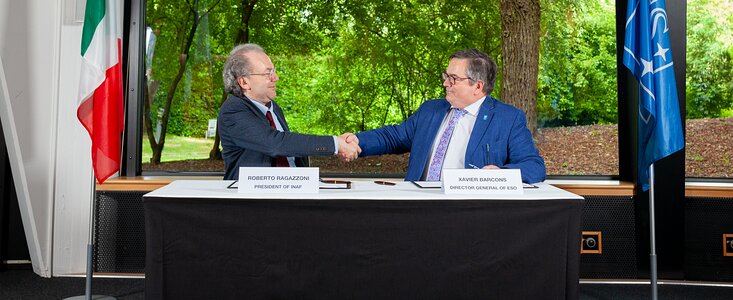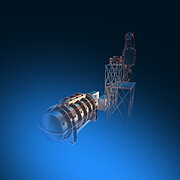Tiedote
ESO on allekirjoittanut sopimuksen ELT:n ANDES-instrumentista
5. kesäkuuta 2024
ESO on tänään allekirjoittanut sopimuksen kansainvälisen laitoskonsortion kanssa ANDESin (ArmazoNes high dispersion Echelle Spectrograph) suunnittelusta ja rakentamisesta. ANDES-instrumentti asennetaan ESO:n Erittäin suureen teleskooppiin (ELT). Sen avulla etsitään merkkejä elämästä eksoplaneetoista ja etsitään ensimmäisiä tähtiä sekä testataan fysiikan perusvakioiden vaihtuvuutta, ja mitataan maailmankaikkeuden laajenemisen kiihtyvyyttä.
Sopimuksen allekirjoittivat ESO:n pääjohtaja Xavier Barcons ja ANDES-konsortiota johtavan Italian kansallisen astrofysiikan instituutin (INAF) johtaja Roberto Ragazzoni. Allekirjoitustilaisuuteen osallistuivat myös Italian Münchenin pääkonsuli Sergio Maffettone ja INAF:n ANDESin päätutkija Alessandro Marconi sekä muita ESO:n, INAF:n, ANDES-konsortion ja Italian Münchenin konsulaatin edustajia. Allekirjoitustilaisuus pidettiin ESO:n päämajassa Garchingissa, Saksassa.
ANDES, joka tunnettiin aiemmin nimellä HIRES, on tehokas spektrografi. Se on laite, joka hajottaa valon eri aallonpituuksiin, jotta tähtitieteilijät voivat määrittää tähtitieteen tutkimuskohteiden tärkeitä ominaisuuksia, kuten niiden kemiallisen koostumuksen. Laitteella on ennätyksellisen suuri aallonpituustarkkuus näkyvän valon alueella ja lähi-infrapuna-alueella. Sen toimiessa yhdessä ELT:n tehokkaan peilijärjestelmän kanssa laite tulee mahdollistamaan laajalti eri tähtitieteen alojen tutkimuksen.
”ANDES on instrumentti, jolla on valtava potentiaali uraauurtaviin tieteellisiin löytöihin, jotka voivat vaikuttaa syvällisesti käsitykseemme maailmankaikkeudesta, joiden merkitys ulottuu pienen tiedeyhteisön ulkopuolelle”, Marconi sanoi. ANDESia seuravan ESO:n tutkimusryhmän projektitutkija Céline Péroux lisäsi, että tieteelliset kohteet vaihtelevat ”mahdollisista muiden maailmojen elämän merkkien havaitsemisesta ja ensimmäisen sukupolven tähtien tunnistamisesta fysiikan perusvakioiden vaihtelun tutkimiseen”.
ANDES tulee tekemään tarkkoja tutkimuksia maankaltaisten eksoplaneettojen ilmakehistä, minkä ansiosta tähtitieteilijät voivat etsiä laajalti merkkejä elämästä. Se pystyy myös analysoimaan kaukaisten maailmankaikkeuden alkuvaiheen kohteiden kemiallisia alkuaineita. Se on todennäköisesti ensimmäinen laite, joka pystyy havaitsemaan merkkejä populaatio III:n tähdistä, jotka ovat maailmankaikkeuden varhaisimpia tähtiä. Lisäksi tähtitieteilijät voivat käyttää ANDESin dataa testatakseen, muuttuvatko fysiikan perusvakiot ajassa ja avaruudessa. ANDESin laajan tietoaineiston avulla voidaan myös suoraan mitata maailmankaikkeuden laajenemisen kiihtyvyyttä, joka on yksi suurista maailmankaikkeuden mysteereistä.
ESO:n ELT:tä rakennetaan parhaillaan Atacaman autiomaassa Pohjois-Chilessä. Kun ELT aloittaa toimintansa myöhemmin tällä vuosikymmenellä, siitä tulee maailman suurin taivaalle katsova silmä, mikä merkitsee maanpäällisen tähtitieteen uutta aikakautta.
Lisätietoja
ANDES-hanketta kehittää kansainvälinen konsortio, joka koostuu 13 maan tutkimuslaitoksista, jotka ovat:
- Brasilia: Board of Stellar Observational Astronomy, Universidade Federal do Rio Grande do Norte, Observatório Nacional.
- Kanada: Observatoire du Mont-Mégantic ja Trottier Institute for Research on Exoplanets, Université de Montréal.
- Tanska: Tanskan astrofysiikan laitekeskus Niels Bohr Instituutin puolesta, Århusin yliopisto, Danmarks Tekniske Universitet.
- Ranska: Centre National de la Recherche Scientifique (CNRS) Observatoire de la Côte d'Azurin puolesta, Université Côte d'Azur (LAGRANGE), Laboratoire d'Astrophysique de Marseille, Aix-Marseille Université, Centre National d'Etudes Spatiales (LAM), Institut de Recherche en Astrophysique et Planetologie, Université Toulouse III-Paul Sabatier (IRAP) puolesta, Institut de Planétologie et d'Astrophysique de Grenoble, Université Grenoble-Alpes (IPAG), Laboratoire Univers et Particules de Montpellier, Université de Montpellier (LUPM), Institut d'Astrophysique de Paris, Sorbonne Université (IAP), Laboratoire de Météorologie Dynamique, Ecole Normale Supérieure, Ecole Polytechnique, Sorbonne Université (LMD).
- Saksa: Leibniz-Institut für Astrophysik Potsdam (AIP), Institut für Astrophysik und Geophysik, Georg-August-Universität Göttingen (IAG), Exoplaneettojen ilmakehän fysiikan osasto, Max-Planck-Institut für Astronomie Heidelberg (MPIA), Zentrum für Astronomie, Universität Heidelberg (ZAH), Thüringer Landessternwarte Tautenburg (TLS), Hamburger Sternwarte, Universität Hamburg (UHH).
- Italia: INAF, Istituto Nazionale di Astrofisica (johtava tekninen instituutti).
- Puola: Nicolaus Copernicus -yliopisto Torunissa.
- Portugali: Instituto de Astrofísica e Ciências do Espaço (IA) Centro de Investigaço em Astronomia/Astrofísica da Universidade do Portossa (CAUP), Instituto de Astrofísica e Ciências do Espaço Faculdade de Ciências da Universidade de Lisboa, Associação para a Investigação e Desenvolvimento de Ciências (FCiências.ID).
- Espanja: Instituto de Astrofísica de Canarias (IAC); Consejo Superior de Investigaciones Científicas (CSIC, Espanja) Instituto de Astrofísica de Andalucían puolesta (IAA), Centro de Astrobiología de Madrid (CSIC-INTA).
- Ruotsi: Lundin yliopisto, Tukholman yliopisto, Uppsalan yliopisto.
- Sveitsi: Département d'Astronomie, Université de Genève; Weltraumforschung und Planetologie, Physikalisches Institut, Universität Bern.
- Yhdistynyt kuningaskunta: Science and Technology Facilities Council, United Kingdom Research and Innovation Cambridgen yliopiston Cavendish Laboratory & Institute of Astronomy -instituutin puolesta; UK Astronomy Technology Centre; Institute of Photonics and Quantum Sciences, Heriot-Watt University.
- Yhdysvallat: Michiganin yliopiston tähtitieteen laitos.
Linkit
Yhteystiedot
Alessandro Marconi
ANDES Principal Investigator
Department of Physics and Astronomy, University of Florence, Italia
INAF-Arcetri Astrophysical Observatory, Italia
S-posti: alessandro.marconi@inaf.it, alessandro.marconi@unifi.it
Céline Péroux
ESO Project Scientist for ANDES
S-posti: cperoux@eso.org
Juan Carlos Muñoz Mateos
ESO Media Manager
Garching bei München, Saksa
Puh.: +49 89 3200 6176
S-posti: press@eso.org
Tiedotteesta
| Tunnistus: | ann24010 |
Our use of Cookies
We use cookies that are essential for accessing our websites and using our services. We also use cookies to analyse, measure and improve our websites’ performance, to enable content sharing via social media and to display media content hosted on third-party platforms.
ESO Cookies Policy
The European Organisation for Astronomical Research in the Southern Hemisphere (ESO) is the pre-eminent intergovernmental science and technology organisation in astronomy. It carries out an ambitious programme focused on the design, construction and operation of powerful ground-based observing facilities for astronomy.
This Cookies Policy is intended to provide clarity by outlining the cookies used on the ESO public websites, their functions, the options you have for controlling them, and the ways you can contact us for additional details.
What are cookies?
Cookies are small pieces of data stored on your device by websites you visit. They serve various purposes, such as remembering login credentials and preferences and enhance your browsing experience.
Categories of cookies we use
Essential cookies (always active): These cookies are strictly necessary for the proper functioning of our website. Without these cookies, the website cannot operate correctly, and certain services, such as logging in or accessing secure areas, may not be available; because they are essential for the website’s operation, they cannot be disabled.
Functional Cookies: These cookies enhance your browsing experience by enabling additional features and personalization, such as remembering your preferences and settings. While not strictly necessary for the website to function, they improve usability and convenience; these cookies are only placed if you provide your consent.
Analytics cookies: These cookies collect information about how visitors interact with our website, such as which pages are visited most often and how users navigate the site. This data helps us improve website performance, optimize content, and enhance the user experience; these cookies are only placed if you provide your consent. We use the following analytics cookies.
Matomo Cookies:
This website uses Matomo (formerly Piwik), an open source software which enables the statistical analysis of website visits. Matomo uses cookies (text files) which are saved on your computer and which allow us to analyze how you use our website. The website user information generated by the cookies will only be saved on the servers of our IT Department. We use this information to analyze www.eso.org visits and to prepare reports on website activities. These data will not be disclosed to third parties.
On behalf of ESO, Matomo will use this information for the purpose of evaluating your use of the website, compiling reports on website activity and providing other services relating to website activity and internet usage.
Matomo cookies settings:
Additional Third-party cookies on ESO websites: some of our pages display content from external providers, e.g. YouTube.
Such third-party services are outside of ESO control and may, at any time, change their terms of service, use of cookies, etc.
YouTube: Some videos on the ESO website are embedded from ESO’s official YouTube channel. We have enabled YouTube’s privacy-enhanced mode, meaning that no cookies are set unless the user actively clicks on the video to play it. Additionally, in this mode, YouTube does not store any personally identifiable cookie data for embedded video playbacks. For more details, please refer to YouTube’s embedding videos information page.
Cookies can also be classified based on the following elements.
Regarding the domain, there are:
- First-party cookies, set by the website you are currently visiting. They are stored by the same domain that you are browsing and are used to enhance your experience on that site;
- Third-party cookies, set by a domain other than the one you are currently visiting.
As for their duration, cookies can be:
- Browser-session cookies, which are deleted when the user closes the browser;
- Stored cookies, which stay on the user's device for a predetermined period of time.
How to manage cookies
Cookie settings: You can modify your cookie choices for the ESO webpages at any time by clicking on the link Cookie settings at the bottom of any page.
In your browser: If you wish to delete cookies or instruct your browser to delete or block cookies by default, please visit the help pages of your browser:
Please be aware that if you delete or decline cookies, certain functionalities of our website may be not be available and your browsing experience may be affected.
You can set most browsers to prevent any cookies being placed on your device, but you may then have to manually adjust some preferences every time you visit a site/page. And some services and functionalities may not work properly at all (e.g. profile logging-in, shop check out).
Updates to the ESO Cookies Policy
The ESO Cookies Policy may be subject to future updates, which will be made available on this page.
Additional information
For any queries related to cookies, please contact: pdprATesoDOTorg.
As ESO public webpages are managed by our Department of Communication, your questions will be dealt with the support of the said Department.


